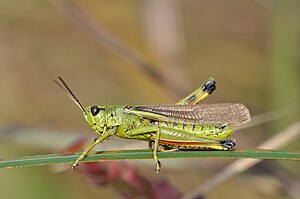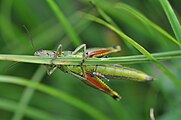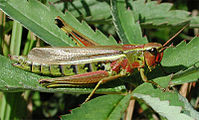Marsh insect
| Marsh insect | ||||||||||||
|---|---|---|---|---|---|---|---|---|---|---|---|---|

Marsh insect ( Stethophyma grossum ) |
||||||||||||
| Systematics | ||||||||||||
|
||||||||||||
| Scientific name | ||||||||||||
| Stethophyma grossum | ||||||||||||
| ( Linnaeus , 1758) |
The marsh insect ( Stethophyma grossum , syn .: Mecostethus grossus ) is a short-antennae insect from the family of field locusts (Acrididae).
description
The marsh insect grows up to four centimeters. It is usually olive green to dark brown. In females there is sometimes a purple, piebald coloring. The coloring varies considerably. The forewings have a yellow stripe on the lower edge and the hind legs are colored red-orange on the underside. The back knees are usually colored conspicuously black. There are a number of black thorns on the back rails. Swamp horrors do not chirp like other grasshoppers, but they make clicking sounds that can be heard from far away. To do this, the marsh insect lifts its hind leg and flings it backwards. The terminal spines on the hind leg are pulled suddenly over the wing. She usually repeats this sound at longer intervals. The females rarely sing. The adult animals can be observed between July and October after they have gone through five larval stages. However, the adult marsh terrors only live a maximum of 53 days. The larvae have the highest moisture requirements of all European species. Marsh terrors feed on sweet grasses and sedge grasses.
habitat
The marsh insect prefers wet and wet meadows , which are used either as meadow or pasture. The eggs are laid in the topsoil in summer. Since the eggs are not well protected against dehydration, sufficient moisture in the soil is of great importance until next summer. The species can repopulate new locations in the range of a few hundred meters due to its good flight ability. The marsh locust relies on wetlands and was once widespread and common. Due to the drainage of floodplains and the intensive use of former wet meadows, the species has become very rare.
literature
- Heiko Bellmann : Locusts: observe, determine , Naturbuch Verlag 1993, ISBN 3-894-40028-5
- Heiko Bellmann : grasshoppers. The voices of 61 native species. CD, Amp Europe 2004, ISBN 3-935-32948-2



